Are you tired of throwing away leftover cooked rice because it’s gone bad? Preserving cooked rice without refrigeration is possible with the right techniques and methods. In this section, we’ll explore various rice preservation techniques to help you keep your cooked rice fresh and safe to consume for an extended period.
With these methods, you can have the convenience of cooked rice without the risk of foodborne illness or spoilage. Let’s dive in and explore the wonderful world of cooked rice preservation!
Key Takeaways:
- Cooked rice can be preserved without refrigeration.
- Proper storage and handling techniques are crucial.
- Methods such as vacuum sealing, dehydrating, and using preservatives can extend the shelf life of cooked rice.
Understanding the Importance of Rice Preservation
Preserving cooked rice without a fridge can be challenging, but it is essential to maintain its quality and prevent spoilage. Storing cooked rice without refrigeration necessitates a thorough understanding of the importance of rice preservation.
Rice preservation is crucial for preventing the growth of bacteria and mold that can cause foodborne illnesses and spoilage. When cooked rice is left at room temperature for an extended period, it can become a breeding ground for microorganisms leading to unpleasant odors and flavors, as well as serious health consequences.
To avoid such risks, it is vital to ensure that cooked rice is stored correctly and under the right conditions. This requires implementing proper storage techniques that can preserve cooked rice without refrigeration for an extended period.
In the following sections, we will explore various methods and techniques that can help you preserve cooked rice without the need for refrigeration and keep it fresh and safe to consume.
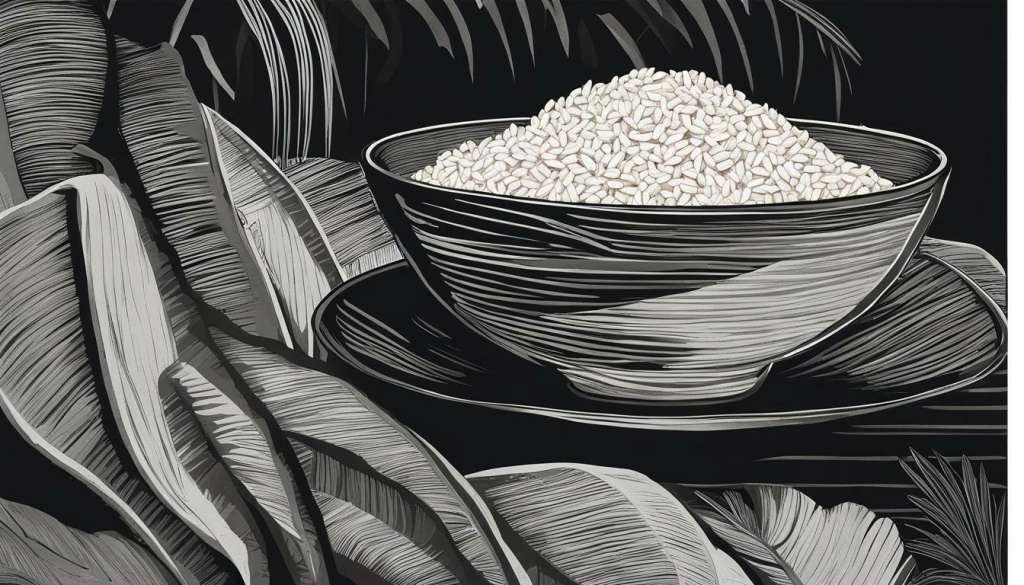
Properly Cooking Rice for Long-lasting Storage
Properly cooking rice is key to achieving long-lasting storage without refrigeration. The first step is to measure the rice accurately. The recommended ratio is two cups of water to one cup of rice.
Start by rinsing the rice thoroughly until the water runs clear. Then, add the rice and water to a pot and bring it to a boil. Once boiling, reduce the heat to low and cover the pot with a tight-fitting lid. Let it simmer for around 18-20 minutes.
After the cooking time is complete, remove the pot from the heat and let it sit with the lid on for an additional 5-10 minutes. This will allow the rice to continue cooking and absorb the remaining water.
Once the rice has finished cooking, transfer it to a shallow container to cool. This will allow it to cool more quickly and reduce the risk of bacterial growth. Use a fork to fluff the rice occasionally while it is cooling to prevent clumping.
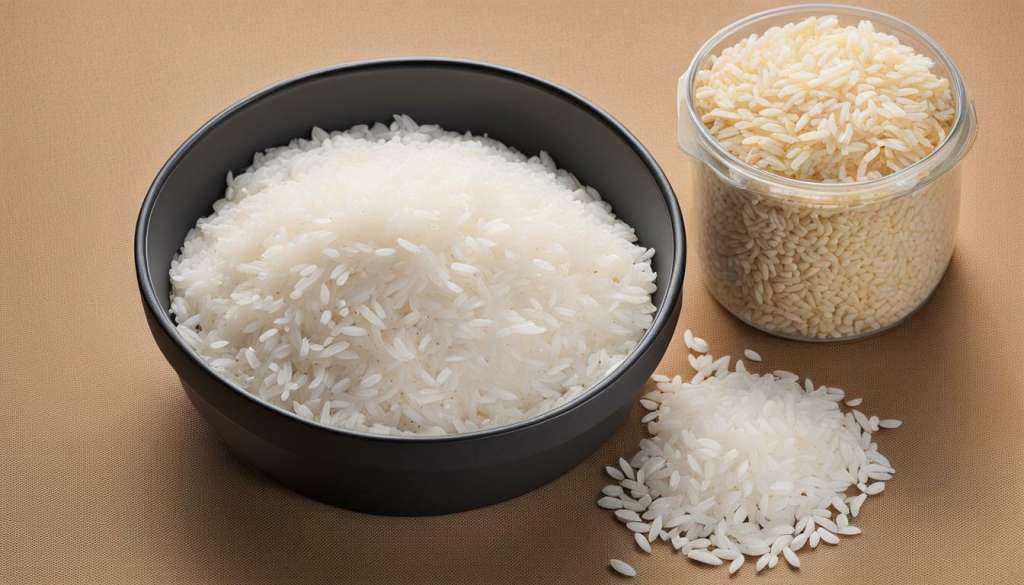
It’s important to note that rice should be cooked just until tender. Overcooking can result in a mushy texture and reduce its shelf life. By following these steps, you can ensure that your rice is cooked properly and ready for long-term storage without refrigeration.
Cooling and Storing Cooked Rice at Room Temperature
If you don’t have access to a refrigerator, storing cooked rice can be challenging. However, there are ways to store rice at room temperature without refrigeration.
The key to storing cooked rice at room temperature is to get it into the right container quickly after it is cooked. A wide, shallow container is best for cooling the rice quickly. A large baking sheet or shallow bowl will work well. Avoid using a deep container, as it will take longer for the rice to cool, increasing the risk of bacterial growth.
After the rice has cooled to room temperature, transfer it to an airtight container. A plastic container with a tight-fitting lid or a resealable plastic bag will work well. Make sure to press out as much air as possible before sealing the container. Rice stored in an airtight container can last up to 24-48 hours at room temperature without refrigeration.
It’s essential to portion the rice appropriately before storing it. Large portions of rice take longer to cool down, which increases the risk of bacterial growth. Therefore, it is best to store rice in smaller portions. A good rule of thumb is to portion rice for storage according to the number of people who will be consuming it, rather than cooking and storing it all at once.
Finally, always monitor the rice for any signs of spoilage. If the rice smells sour or has a slimy texture, it’s best to discard it. Properly stored rice should have a neutral scent and be dry and fluffy.
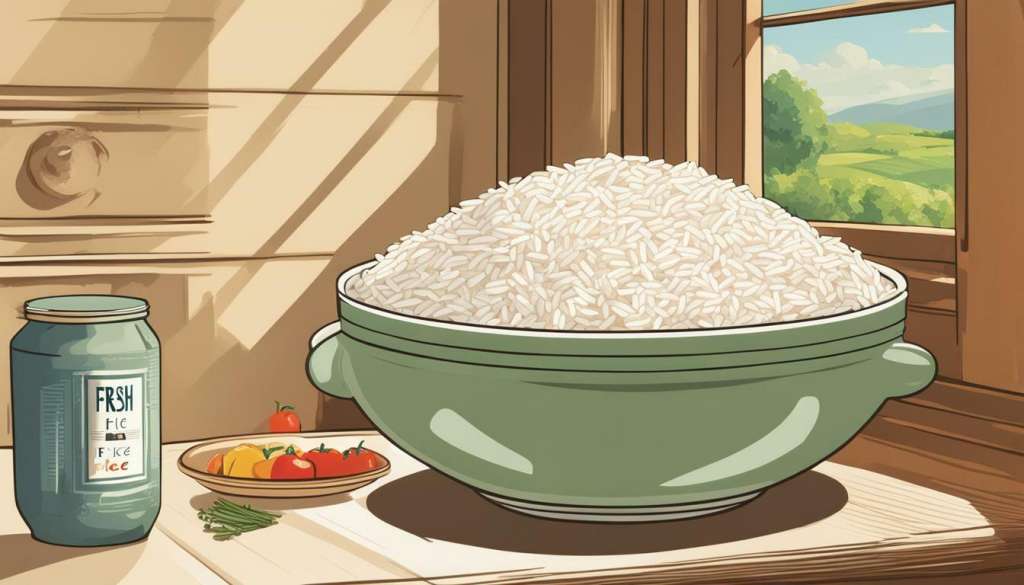
Container Options
When it comes to storing cooked rice without refrigeration, the right container makes all the difference. Here are some container options to consider:
| Container Type | Pros | Cons |
|---|---|---|
| Plastic container with a tight-fitting lid | Reusable, airtight, and easy to find | Takes up more space than a plastic bag and usually more expensive |
| Resealable plastic bag | Takes up less space, easy to portion rice | Not reusable, can puncture or tear easily |
| Glass container with a lid | Reusable, easy to clean | Heavy and not as portable as plastic or resealable bags |
Choose the container that best fits your needs and make sure to clean it thoroughly before use.
Utilizing Vacuum Sealing for Rice Preservation
Vacuum sealing is an effective method for preserving cooked rice without refrigeration. It works by removing all the air from the packaging, which inhibits the growth of bacteria and fungi that can cause rice to spoil.
To vacuum-seal cooked rice:
- Cool the rice to room temperature.
- Portion out the rice into individual servings, using a measuring cup or a kitchen scale to ensure consistency.
- Place each portion of rice into a vacuum-seal bag or container specifically designed for use with a vacuum sealer.
- Seal the bag or container according to the manufacturer’s instructions using a vacuum sealer.
One of the biggest benefits of vacuum-sealing cooked rice is that it can extend the shelf life of the rice up to five times longer than other preservation methods. This means that vacuum-sealed rice can last up to a year without losing its quality and freshness.
It’s important to note that while vacuum-sealing is an excellent method for rice preservation, it isn’t foolproof. Any air leaks in the packaging will allow bacteria and fungi to grow, potentially causing the rice to spoil. Be sure to check the seal on the bags or containers carefully before storing them.
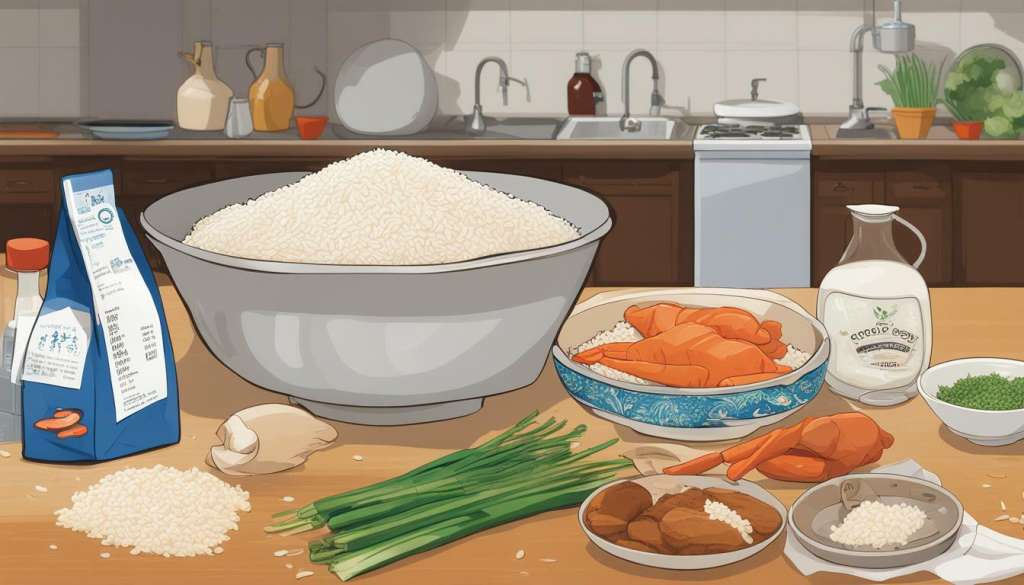
In addition to preserving cooked rice without refrigeration, vacuum sealing is also a handy way to store a variety of other foods, including meats, fruits, and vegetables.
Dehydrating Cooked Rice for Long-term Storage
Dehydrating cooked rice is a popular method for extending its shelf life. This technique involves removing all moisture from the rice, making it less prone to spoilage. Dehydrated rice is a great option for long-term storage, as it can last for months without refrigeration.
To dehydrate cooked rice, spread it out on a baking sheet or dehydrator tray in a thin layer. Set the temperature to 135°F and leave it in the dehydrator for several hours until it becomes completely dry and brittle.
Once the rice is fully dehydrated, transfer it to an airtight container, like a mason jar or a vacuum-sealed bag. Keep the container in a cool, dry place away from direct sunlight.
When ready to use the dehydrated rice, simply soak it in water until it becomes soft again. You can also add dehydrated rice directly to soups, stews, and other dishes that require cooking with liquid.
| Pros | Cons |
|---|---|
| Long-lasting storage without refrigeration. | Extra time and equipment required for dehydrating. |
| Lightweight, great for camping or backpacking trips. | Dehydrated rice requires rehydration before use, adding cooking time. |
| Dehydrated rice takes up less space than cooked rice. | Dehydration can alter the texture and flavor of the rice. |
Dehydrating cooked rice is a great way to have rice readily available for an extended period, perfect for camping trips or to have on hand during emergencies.
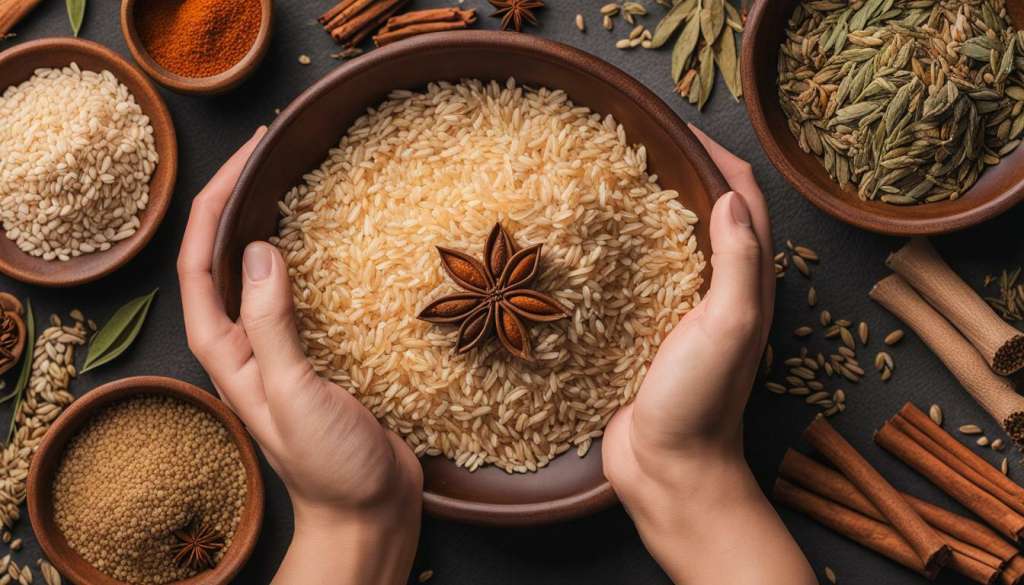
Using Preservatives to Extend the Shelf Life of Rice
If you’re looking for an effective way to preserve cooked rice without refrigeration, using preservatives may be a viable option. Natural and commercial preservatives can help limit bacterial growth and prevent spoilage, allowing you to store cooked rice at room temperature for an extended period.
| Common Natural Preservatives | Common Commercial Preservatives |
|---|---|
| Vinegar – acetic acid in vinegar inhibits bacterial growth | Sodium benzoate – prevents growth of bacteria, yeasts, and molds |
| Lemon juice – high acidity inhibits bacterial growth | Propionates – prevents growth of bacteria and molds |
| Garlic – allicin in garlic acts as a natural antibiotic | Nitrates and nitrites – used in meat preservation to prevent bacterial growth and enhance color |
It is essential to follow recommended guidelines when using preservatives to preserve cooked rice. Always use the recommended amount and apply the preservative uniformly to avoid uneven distribution, which can lead to spoilage.
While preservatives can extend the shelf life of cooked rice, they should not be solely relied on. Proper storage practices, including sealing and monitoring temperatures, are still crucial to maintaining the quality and safety of cooked rice.
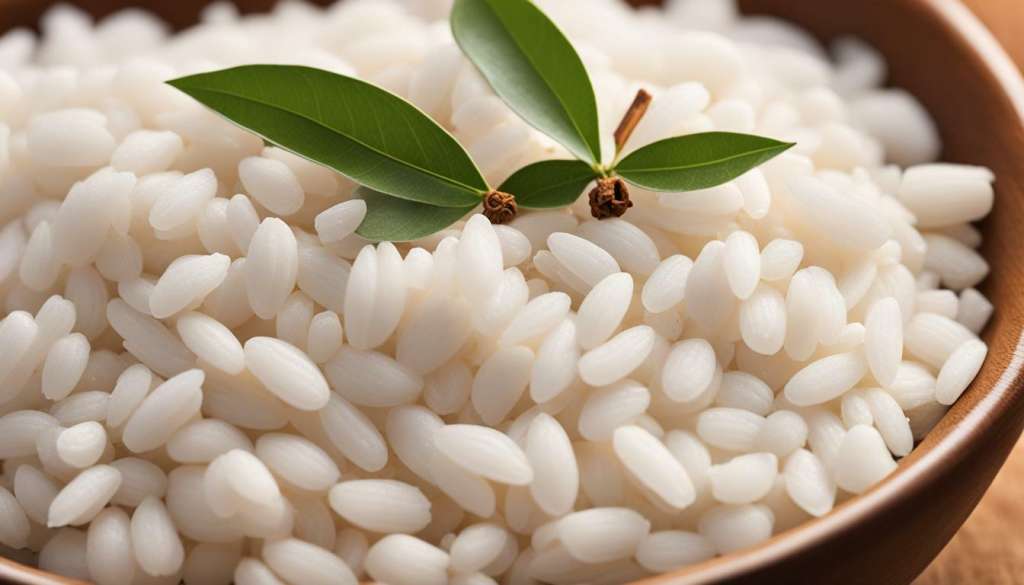
Preservatives can be a valuable tool for extending the shelf life of cooked rice. Whether using natural or commercial options, always follow recommended guidelines and supplement with proper handling and storage practices.
Tips for Preventing Rice Spoilage
Proper handling and storage practices are essential for preventing rice spoilage and ensuring its long-lasting preservation without refrigeration. Here are some valuable tips to keep in mind:
- Seal the cooked rice properly to prevent moisture and air from entering. Store in an airtight container with a lid to prevent contamination and oxidation.
- Store cooked rice in a cool, dry, and well-ventilated area away from direct sunlight. High temperatures and humidity can trigger bacterial growth that can spoil the rice quickly.
- Store cooked rice in small portions rather than a large container to avoid exposing the rice to air and heat every time you need to take out some rice.
- Monitor the rice for any signs of spoilage, such as an off smell or appearance. Discard any rice that appears moldy, discolored, or slimy to avoid cross-contamination.
- Avoid leaving cooked rice at room temperature for more than two hours to minimize the risk of bacterial growth and spoilage.
By following these guidelines, you can significantly reduce the risk of rice spoilage and ensure that your cooked rice stays fresh and safe to consume for an extended period.
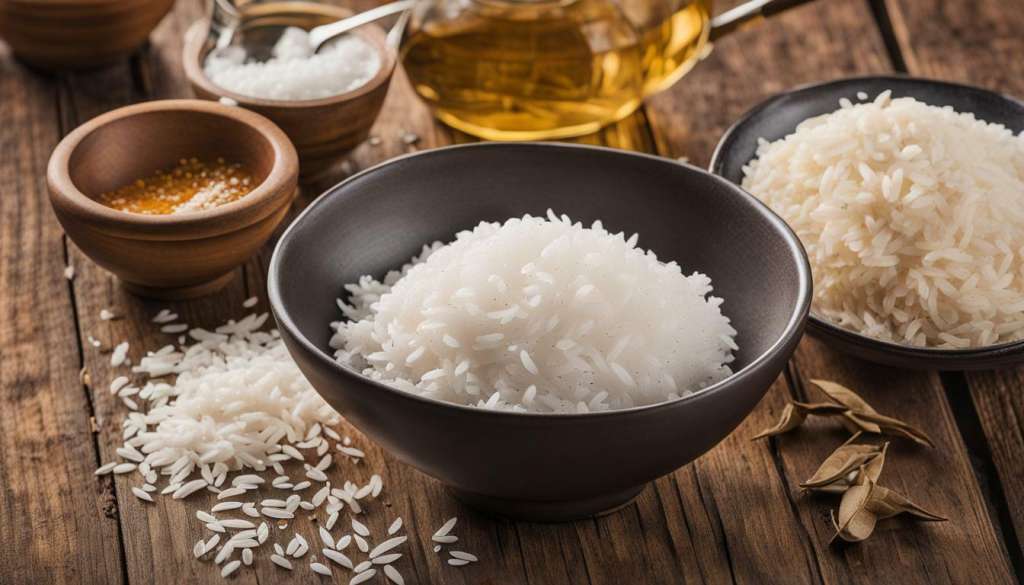
Reheating Rice Safely
When it comes to reheating rice that has been stored without refrigeration, it’s crucial to follow proper food safety guidelines to prevent the risk of foodborne illnesses.
The safest way to reheat rice is by using a microwave or oven, ensuring that the rice reaches a temperature of at least 165°F (74°C) to kill any bacterial growth. It’s also essential to reheat rice within two hours of its initial cooking and to avoid leaving it at room temperature for an extended period.
If you’re reheating rice that has been stored in the freezer, defrost it in the refrigerator before reheating it. You can also add a splash of water or broth to the rice before reheating to help prevent it from drying out.
It’s important to note that reheating rice multiple times can lead to a higher risk of bacterial growth, so it’s best to only reheat the amount of rice you plan on consuming.
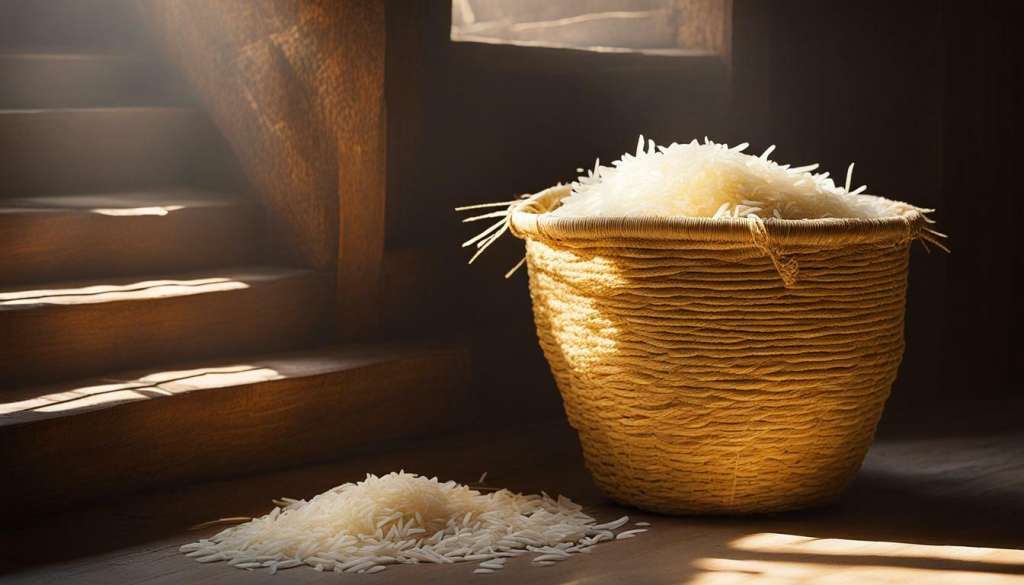
By following these guidelines, you can enjoy your preserved rice without worrying about the risk of food poisoning.
Creative Ways to Use Preserved Cooked Rice
Preserving cooked rice opens up endless possibilities for incorporating it into various dishes. Here are some creative ideas and recipes to make the most out of your preserved cooked rice:
Fried Rice
Fried rice is a classic dish that is quick and easy to make. Simply stir-fry your preserved cooked rice with your choice of meat, vegetables, and seasonings for a delicious meal.
Rice Salad
Rice salad is an excellent option for a light and healthy meal. Mix your preserved cooked rice with your choice of fresh vegetables, herbs, and dressing for a tasty and nutritious dish.
Rice Pudding
Rice pudding is a comforting and satisfying dessert that is easy to make with your preserved cooked rice. Combine cooked rice with milk, sugar, and your choice of spices, and cook until creamy and delicious.
Rice and Beans
Rice and beans are a staple dish in many cultures around the world. Mix your preserved cooked rice with beans, spices, and your choice of meat for a hearty and flavorful meal.
Casserole
Rice casseroles are a comforting and versatile dish that you can make with your preserved cooked rice. Mix rice with your choice of vegetables, meat, and cheese for a delicious and easy meal.
Stuffed Peppers
Stuffed peppers are a tasty and healthy dish that you can make with your preserved cooked rice. Stuff peppers with a mixture of rice, meat, and vegetables, and bake until tender and delicious.
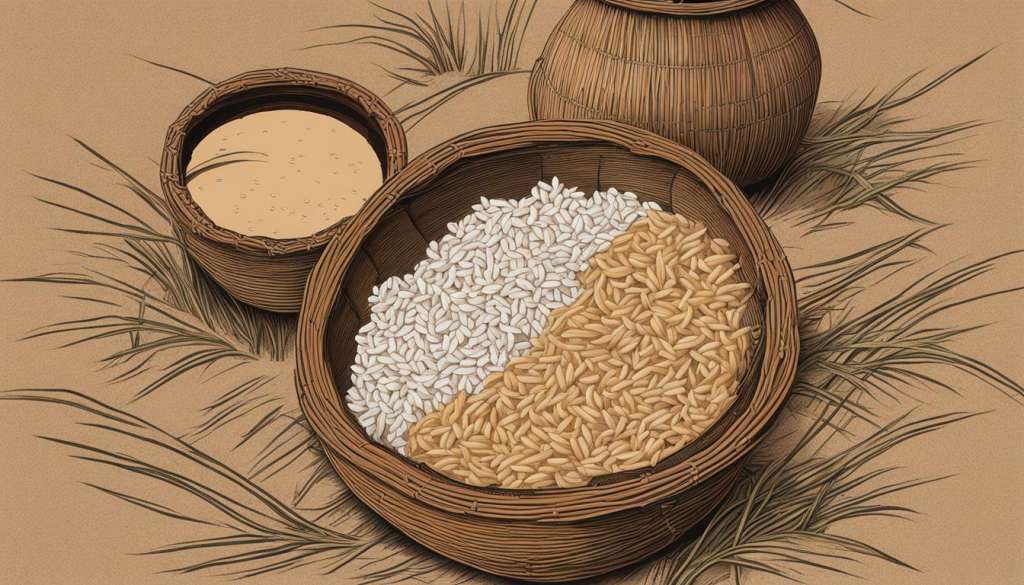
These are just a few examples of the many ways you can use your preserved cooked rice in various dishes. With a little creativity and experimentation, you can enjoy delicious and nutritious meals using your preserved cooked rice.
Conclusion
Preserving cooked rice without refrigeration may seem daunting, but it is entirely possible with the right techniques and methods. By understanding the importance of proper rice preservation, cooking rice correctly, and utilizing methods such as vacuum sealing and dehydrating, you can extend the shelf life of your cooked rice significantly.
Remember to keep in mind the guidelines for storing and reheating rice safely and preventing spoilage. With these tips and tricks, you can make the most out of your preserved cooked rice by trying out creative recipes and dishes.
Don’t let good rice go to waste. Start mastering the skill of rice preservation today, and you’ll never have to worry about tossing out leftover rice again!
FAQ
Q: How long can cooked rice be preserved without refrigeration?
A: Cooked rice can be preserved at room temperature for up to 2 hours. After that, it should be refrigerated or discarded.
Q: Can cooked rice be stored at room temperature overnight?
A: It is not recommended to store cooked rice at room temperature overnight as it increases the risk of bacterial growth. It is best to refrigerate leftover cooked rice within 2 hours of cooking.
Q: Can I freeze cooked rice for long-term storage?
A: Yes, cooked rice can be frozen for long-term storage. Make sure to cool the rice completely before transferring it to a freezer-safe container or bag. It can be stored in the freezer for up to 6 months. Thaw and reheat thoroughly before consuming.
Q: How can I tell if cooked rice has gone bad?
A: Cooked rice that has gone bad may have a sour or strange odor and may appear discolored or moldy. If you are unsure about the quality, it is best to discard it to avoid foodborne illnesses.
Q: Can I reheat preserved cooked rice?
A: Yes, preserved cooked rice can be reheated. Ensure that it is heated to an internal temperature of 165°F (74°C) to kill any potential bacteria. Use a microwave or stovetop to reheat thoroughly.
Q: Are there any alternative methods to preserve cooked rice without refrigeration?
A: Yes, aside from refrigeration, you can preserve cooked rice without refrigeration by using techniques such as vacuum sealing, dehydrating, and utilizing preservatives. These methods can help extend the shelf life of cooked rice.
Q: Can preserved cooked rice be used in other dishes?
A: Absolutely! Preserved cooked rice can be used in various dishes such as fried rice, rice salads, rice bowls, and even desserts. Get creative and experiment with different recipes to enjoy your preserved rice in new and delicious ways.
Q: Are there any safety precautions I should take when preserving cooked rice without refrigeration?
A: When preserving cooked rice without refrigeration, make sure to practice proper hygiene, use clean utensils and containers, and follow the recommended guidelines for each preservation method. It’s also important to monitor the rice for any signs of spoilage or contamination.


